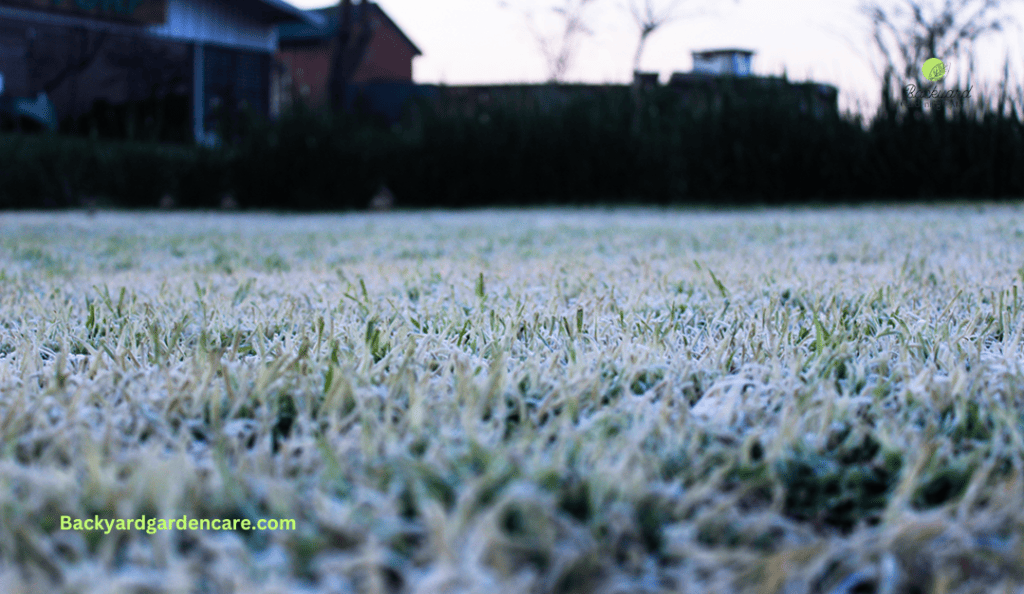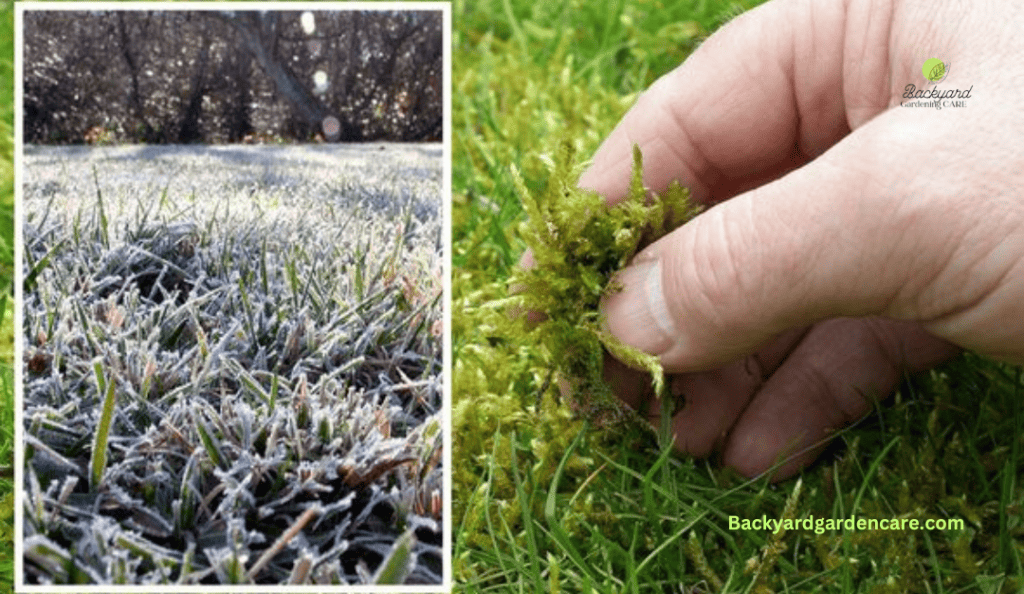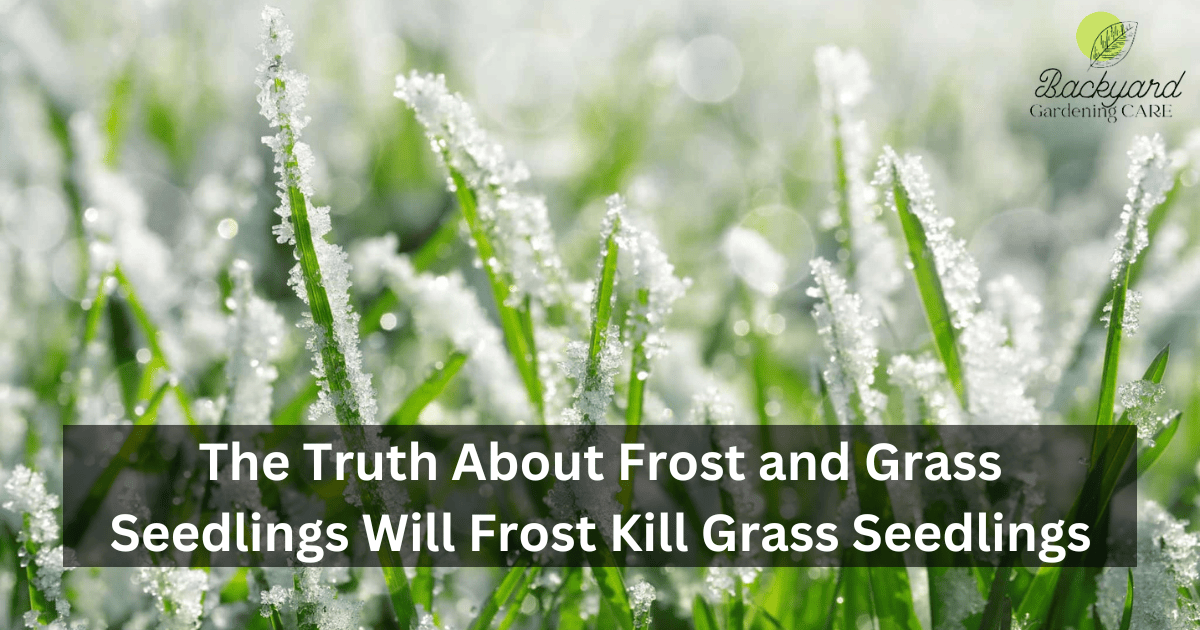Will Frost Kill Grass Seedlings? The Truth About Frost and Grass Seedlings
As the weather shifts towards cooler temperatures, many gardeners and lawn enthusiasts may wonder about the effects of frost on their grass seedlings.
Grass seedlings are vulnerable to frost damage because they have not yet developed the deep root systems of established grasses. This means they are more likely to suffer from moisture stress, making them more susceptible to frost damage.
If you have annual grass seedlings, then frost can kill them. But if you have perennial grass seedlings, they will likely survive frost. This is because annual grasses are more delicate and sensitive to changes in temperature than perennial grasses.
However, even if you have perennial grass seedlings, frost can still damage them. The extent of the damage will depend on the weather conditions and how long the frost lasts.
There are many variables that affect a plant’s susceptibility to frost damage, including the type of grass, the stage of growth, and the amount of time the plant is exposed to frost.

Let’s discuss all the factors that impact the will frost kill grass seedlings.
Will Frost Kill Grass Seedlings? Important to Understand

There are many homeowners who start worrying about the effects of the winter months on their lawn seedlings as the winter months approach. While frost can pose a threat to young plants, it is important to understand the extent of the damage it can cause and how to mitigate those effects.
First of all, it is important to understand what frost is and how it affects plants in the first place. Frost occurs when the temperature drops below freezing, causing water in the air to freeze and form a thin layer of ice on surfaces.
When it comes to grass seedlings, the effects of frost can vary depending on several factors. For example, the type of grass you’ve planted, the seedlings’ age and health, and the frost’s severity and duration can all play a role in determining whether or not they will survive.
This layer of ice can damage tender plant tissues, including grass seedlings. Additionally, frost can cause the soil to freeze, making it difficult for roots to absorb water and nutrients.
It is generally true that grasses that are cold-season in nature, such as Kentucky bluegrass, fescue, and ryegrass, will be more tolerant of frost than grasses that are warm-season in nature, such as Bermuda Grass and Zoysia Grass.
This is because cool-season grasses are adapted to cooler temperatures and can go dormant during winter, effectively shutting down until spring. However, even cool-season grasses can suffer frost damage if the temperatures drop too low or if the frost lasts for an extended period of time.
Grass seedlings less than a month old are generally more vulnerable to frost damage than older, established grass. The damage to grass seedlings may be minimal if the frost is mild and brief.
However, if the frost is severe and prolonged, it can kill off entire patches of grass. Certain types of grass, such as warm-season grasses, are more susceptible to damage from frost than others.
So what can you do to protect your grass seedlings from frost damage? Here are a few tips.
- Choose the right grass. If you live in an area with frequent frosts, consider planting cool-season grasses better equipped to handle the cold.
- Plant at the right time. Try to time your grass planting so the seedlings can establish a strong root system before the first frost.
- Keep an eye on the weather forecast. If frost is predicted, cover your seedlings with a frost blanket or cloth to protect them from the cold. Be sure to remove the cover in the morning once the temperatures rise above freezing.
- Water your seedlings well before a frost. Moist soil can help insulate the roots and protect the plant from frost damage.
- Avoid planting grass seedlings too late in the season. If you live in an area with harsh winters, planting your grass in the early fall is best to give it time to establish before the first frost hits.
- Choose a grass variety that is well-suited to your climate. Talk to a lawn care expert or consult with your local nursery to find out which grasses are best for your area.
Finally, choosing the right time to plant grass seedlings is important. Fall is a good time to plant seedlings, as they will have time to establish themselves before frozen temperatures set in. Additionally, planting grass seedlings after the last frost in the spring can help ensure they are not exposed.
Choosing the Right Time to Plant Cool-season Grass.
For successful growth and establishment, timing is crucial when planting cool-season grass. We will discuss the best time to plant cool-season grass, the effect of frost on grass temperature, and the importance of watering new grass seed before frost.
Choosing the Right Season for Planting.
Planting cool-season grass varieties during the late summer and early fall is generally recommended, as these are the best times.
Selecting the ideal season for planting has been a crucial lesson I’ve learned through my years of gardening. One memorable experience that highlights this lesson occurred when I decided to plant a vibrant assortment of flowers in the early spring.
Eager to kickstart the gardening season, I sowed the seeds amidst chilly mornings and sporadic frosts. Unfortunately, many of my beloved blooms struggled to thrive, succumbing to the unpredictable weather. It became evident that waiting for the warmth of late spring or early summer was the key to success.
Since then, I’ve always made sure to align my planting schedule with the optimal season, ensuring my garden flourishes as nature intended. It’s a lesson that resonates with both novices and seasoned gardeners alike: choosing the right season for planting is the foundation of a garden.
Proper Soil Preparation

Before planting grass seeds, it is essential to ensure that the soil is prepared properly in order to ensure healthy grass growth. A beautiful lawn can be harmed by neglecting to prepare the soil before planting, regardless of when you decide to plant your lawn. For the best results when preparing your soil, follow these steps.
- Test the Soil: To ensure favourable conditions for seedling growth, evaluate your soil’s pH and nutrient levels. As a rule of thumb, the optimal pH range for grass seed germination is between 6.2 and 7.0. Ensure the pH is within the optimal range by adjusting if the pH is too low (acidic) or too high (alkaline).
- Enhance Soil Health: Creating a favourable environment for beneficial microbes in the soil and promoting adequate aeration can effectively enhance the growth and maturation of grass seedlings.
Should I Water New Grass Seed Before Frost?

It is essential to water grass seeds consistently and adequately after planting, especially during the initial stages of germination. When it comes to watering new grass seeds before they are frost-hardened, here are some key considerations:
Moisture for Germination: For the successful germination of seeds, it is crucial to maintain a steady level of moisture. It is recommended to ensure that the seeded region remains consistently moist for at least 2-3 weeks post-planting. This will enable the seeds to soak up water and commence the process of germination.
Watering before Frost: Moistening the newly seeded area before an anticipated frost is recommended. Damp soil is better at retaining warmth, which can protect sensitive grass shoots from icy conditions.
Remember, Over-watering can have negative effects, such as waterlogging or the growth of fungal diseases. Maintaining a harmonious balance is important by keeping the soil consistently moist without causing waterlogging.
To ensure the successful establishment and growth of cool-season grass, prepare the soil properly and water it consistently. The importance of watering before frost and the impact of frost on grass temperature can help you ensure optimal conditions for your newly seeded grass.
Does Straw Protect Grass Seed From Frost?

Many gardeners and homeowners are interested in protecting their grass seed from frost in winter. This conversation often revolves around the question, Does Straw Protect Grass Seed from Frost? There is no doubt that straw can provide some insulation and protection from frost to grass seed.
However, there are a few important factors to consider before deciding to use straw as a protective covering for your grass seed. If you cover the seeded area with straw, you can help insulate the soil and protect it from some of the freezing temperatures that may occur in the area.
The straw will also help to keep the soil moist, which is important for proper seed germination.
Removing the straw once the weather starts to warm up is also important.
Leaving the straw in place for too long can create a breeding ground for pests and diseases and block sunlight from reaching the new grass. Furthermore, it is important to keep in mind that not all types of straw are made equal when it comes to quality.
You must use a clean straw that is free of weed seeds if you want to protect your grass seed from frost effectively. Using a straw containing weed seeds can do more harm than good, as it can introduce unwanted weeds into your lawn.
Furthermore, if you use straws, use them in moderation. A thin layer of straw can provide your grass seed with insulation and protection, but too much straw can actually smother it and prevent it from germinating.
Monitor the temperature regularly if you’re using a straw to protect your grass seed from frost. During the day, remove the straw if the temperature rises above freezing to prevent mold growth and allow the grass to breathe.

Similarly, if the temperature drops below freezing during the day, be sure to cover the seed again with a thin layer of straw. Ultimately, straw can be a helpful tool in protecting newly seeded grass from frost, but it’s not a foolproof solution.
It is important to prepare your grass seed, apply it correctly, and monitor the weather conditions to ensure success. Call a lawn care professional if you are concerned about protecting your grass seed during the winter. With these tips in mind, you can help ensure a healthy and vibrant lawn come springtime.
Conclusion
frost can be detrimental to grass seedlings, especially if they have not yet established strong roots. To protect your grass seedlings from frost damage, it is important to take preventative measures such as covering them with frost sheets or waiting to plant until after the risk of frost has passed.
However, the severity of the damage will vary based on several factors, such as the temperature and duration of the frost, the age and hardiness of the seedlings, and the overall growing conditions. Your grass seedlings can thrive and grow into a healthy, lush lawn with proper care and attention.
FAQs
What Temperature Will Kill Grass Seed?
Grass seeds can be killed by temperatures that are too high or too low. Generally, temperatures above 90°F or below 40°F can be harmful to grass seed. Planting grass seeds during the optimal temperature range for your grass type is important to ensure successful germination. Providing proper watering and other necessary care can also help protect grass seed from extreme temperatures.
How Do I Protect My Grass Seedlings from Snow?
You can cover your grass seedlings with straw or hay to protect them from snow. This will help insulate the soil and protect the seedlings from the cold.
You can also use a frost sheet or burlap to cover the seedlings, securing the edges to prevent wind from blowing it away. Also, avoid walking in the snow-covered area, which can damage the seedlings and delay their growth.
Can Seedlings Handle Frost?
Grass seedlings can generally handle light frost, but extended periods of freezing temperatures can damage or kill them.
It’s important to monitor the weather forecast and take steps to protect your seedlings if necessary, such as covering them with sheets or plastic sheeting overnight. Also, choosing a grass variety adapted to your climate can help increase the chances of successful growth and survival.
How Cold is Too Cold for Grass Seedlings?
Grass seedlings are generally sensitive to extreme temperatures, and cold temperatures can affect their growth and survival. The ideal temperature range for grass seedlings is between 60 and 75 degrees Fahrenheit.
However, if the temperature drops below 40 degrees Fahrenheit, it can be too cold for grass seedlings to grow, and they may die. Therefore, it is recommended to avoid planting grass seedlings in extremely cold temperatures and to wait for more favorable weather conditions.
Jack Ralph

hey, I’m Jack Ralph, a dedicated grass and lawn expert with years of experience creating beautiful outdoor spaces. I can help you achieve the lawn of your dreams, from seeding to mowing, turning your yard into a natural masterpiece.
Look no further—I’m the key to transforming your lawn dreams into reality! and here to help you achieve a lawn that’s not just a patch of grass, but a canvas of natural artistry.







